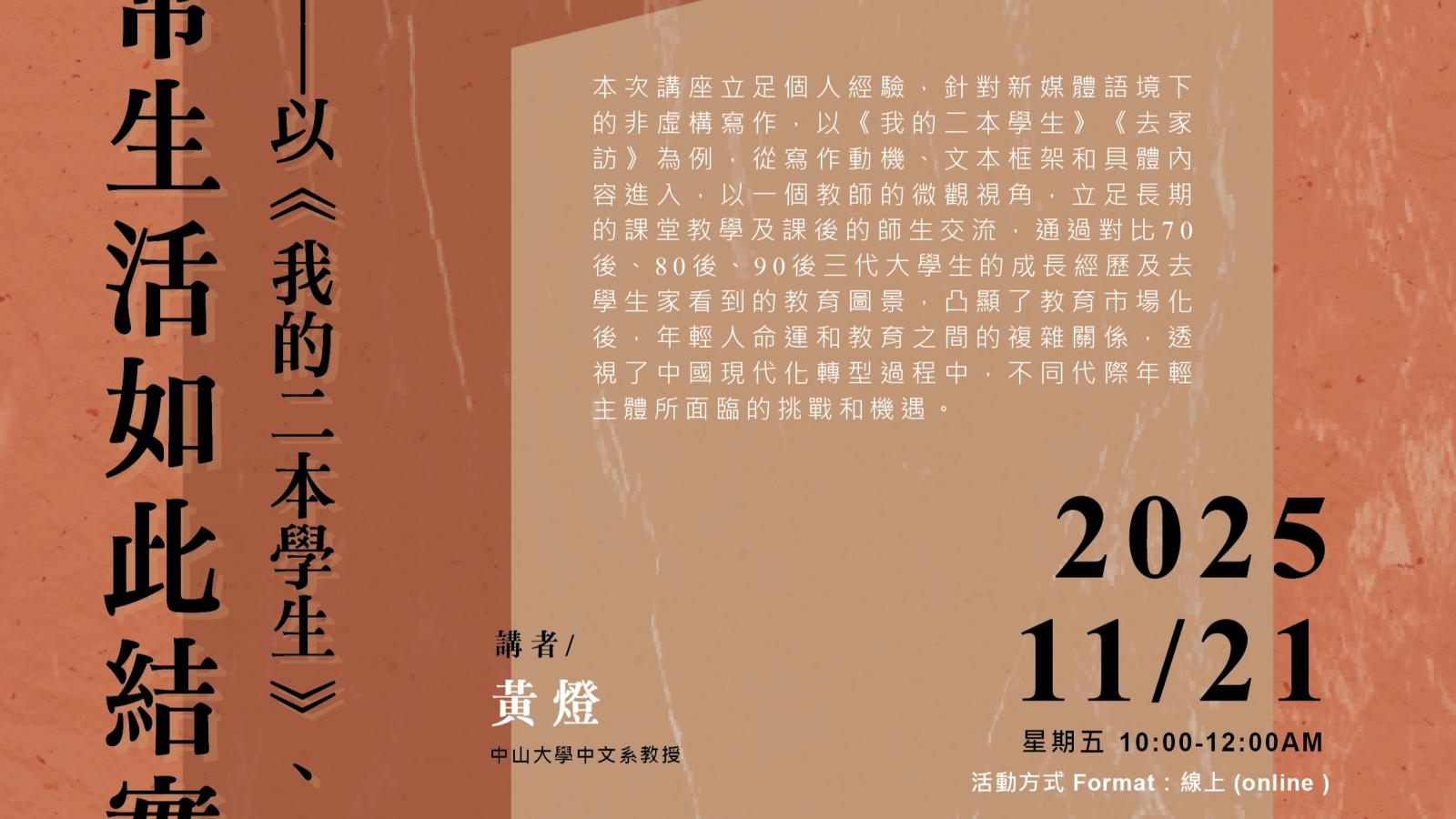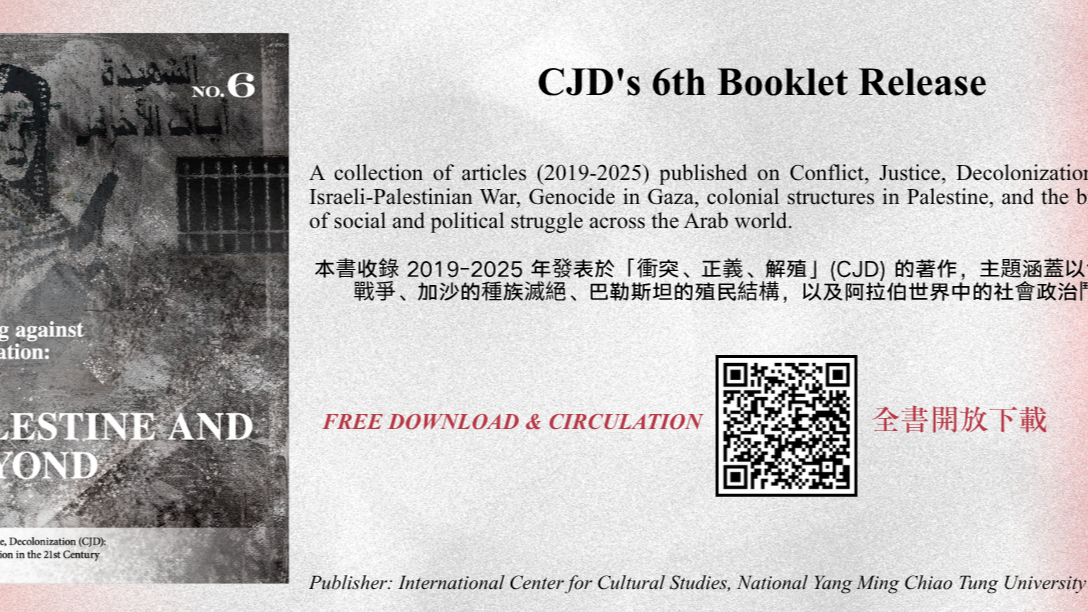

【ACS Institute 2023 -Day 4- 8/13- Activity Report】Ruba Salih - Decolonisation in 21st Century:Pitfalls and Promises
2023-11-14
Ruba Salih - Survivance and decolonial politics. Palestine as “more than” metaphor.
Title: Survivance and settler-colonialism in Palestine beyond national independence
By KWOK Man Yee, Sophie, Master’s student of Inter-Asia Cultural Studies Program, National Tsing Hua University
In this talk, Salih brings together a number of strands of her recent work on the reflection upon decolonial politics. Under the framework of decolonizing, there are three main characteristics of her research over the last few years that include: 1, reflecting on the limits of the ‘national’, including but not limited to Palestine; 2, reflecting on the ongoing operations of settler-colonialism in Palestine or Israel, particularly on the notions of life and non-life; 3, repositioning of Palestine in global justice struggles.
Salih starts by presenting the limits of the national, or the limits of the nation-state as the horizon in thinking about liberation, in Palestine. Palestine has been experiencing a ‘cognitive and experiential dissonance’, according to Salih, where the nation-state of Palestine has not been fully realized as it should have been based on the Peace Act in the early 90s, and already mutilated at the outset. What can be seen is the birth of a conveniently established state of Palestinian sovereignty that does not have the qualities of an independent national sovereign state. There also exists an ongoing colonial violence of dispossession, removal, and destruction, seen in the West Bank, as well as the normalization of ethnic cleansing and racial discrimination in Israel proper. Palestine is considered as a “laboratory” of the reorganization of surveillance and capital accumulation, but at the same time considered to be central in global struggles for social, ecological, and racial justice.
Just like other settler-colonial contexts, there was elimination of indigenous population in Palestine, but it was not done only through physical displacement, destruction, or ecological alteration. What the settlers did was to equate Indigenous Life and Non-life, and to fossilize or desertify both humans and nonhumans in order to turn themselves into the new indigenous as the ultimate aim of the settler colonial project. “Nature” is only assigned to be “Nature” as appropriated by the settlers, which Salih and her colleagues define as “settler-Nature”. Under this context, adopting a decolonial approach can enable us to foreground nature-human entanglements in understanding the operations and the instability of colonial power. Salih proposes to interrogate “the afterlife of nature” and the legible fractures and openings.
The last strand of focus lies on Palestine being central in global justice struggles. Palestine operates as “analytic” (Qutami, 2014) of contemporary manifestations of the coloniality of power, and as a lens to detect racialized systems of exploitation, dispossession, and surveillance. Salih specifically pointed to the notion of “constant struggle” by Angela Davis and Cornel West (2016) that points to the continuities of Palestinian struggles in racial and social justice, to highlight the convergence of movements and peoples who have similarly rooted grievances in the structural violence of Western colonial modernity.
Based upon these premises, Salih situates her talk on the notions of decolonization and decolonizing. She uses Anibal Quijano’s notion of “coloniality of power” which points to the fact that independence does not end colonialism, but that modernity continues to revolve around the production of colonial differences, exploitation, and racialization of black and brown bodies under settler-colonial context. Salih also emphasises on the coloniality of knowledge, where modernity or rationality is the lexicon of knowledge production along the ongoing-ness of colonialism. The radical “absence of the Other” is crucial in the self-constitution of the colonial self; it is where such ongoingness of coloniality rests on. Mignolo’s notion of the need for epistemic delinking from “the rhetoric of modernity” is highlighted as a direction towards how we could rethink the “emancipating ideals of modernity”.
To think beyond the binary definition of colonialism versus national independence, Salih proposes a decolonial framework that sees Palestine as one of the most visible, present-day manifestation of the coloniality of power, with “Thinking Palestine through Standing Rock and Ferguson” being her major argument. Two important dimensions that have helped to rethink itself as an anti-colonial struggle rather than a struggle for national independence are indigeneity and race. Indigeneity is what the notion of “Standing Rock” evokes, where to think of Palestine as a struggle to claim indigeneity expands the imaginaries of liberation beyond liberal nation-state promises, hence tethers Palestine to other indigenous and other struggles around the world. Racial hierarchies between Jews and Arabs, on the other hand, are foundational to the constitution of Israel as an independent nation-state. Salih refers to Lana Tatour’s work on citizenship that looks at the formation of citizenship in a settler-colonial context including Israel allows us to put into deep scrutiny the idea of equality afforded by the myth of the nation-state and the parallel myth of equal citizenship. Like in Australia or the US, the citizenship in Israel operates to normalize domination and to naturalize settler sovereignty by classifying populations, producing differences, and excluding, racializing, and eliminating indigenous people.
Salih goes on to talk about the parallels and intersections between Palestine and the predicaments of Native Americans. First, she mentions Mahmoud Darwish’s poem in 1992 titled “The Red Indian’s Penultimate Speech to the White Man”, which was inspired by the speech of the indigenous chief Duwamish (Chief Seattle’s speech) in 1854 as a response to the treaty of the American Government sanctioning the buying of native Americans’ land. In this poem, there is a clear endorsement of parallels between the Palestinians and indigenous people in North America, and an evocative and moving indigenous critique of settler colonial appropriation can be seen. Salih urges us to reflect on the legacy that has been sidelined, that is, as in Darwish’s poem, the nature/human entanglement and sacredness of the land. Here, “land” is different from the divine mandate to conquer and possess land of the colonizer. She quotes from a Lakota spiritual leader Leonard Crow Dog who said at Standing Rock 2016 to white American land activists that “We don’t own the land; the land owns us”. There is a clear situating in Darwish’s writing early in the 90s of Palestine in relation to native Americans and a clear parallel that is drawn to show how Palestinians see the land – not in terms of possessing and repossessing or in individualist or liberalist terms but in terms of land being a wider spiritual context for rethinking the relationship between human and nature – a very different project compared to patriotic redemption project of the settler-colonialism. Salih invites us to think about the Palestinian critiques of anteriority thesis by scholars such as Elias Sanbar, Edward Said and others, that indigeneity is different from exclusionary nativism.
Talking about disappearance and the politics of presence, Salih quotes from and uses the discussion between Gilles Deleuze and Elias Sanbar titled “Indians of Palestine” in Discourse, 1998. Sanbar raises the important notion of disappearing and argues that this is the only “role” of American Indians of the Jewish settlers in Palestine. Such notion of disappearance is crucial because a constitutive element in the settler nation-state rests upon making the indigenous disappearance. It is more than a material process of erasure or dispossession, but a kind of crucial, cultural, self-making colonial epistemology. Salih points to the important idea raised by Sanbar that since the Zionist movement mobilized the Jewish community with the idea that Palestine was empty, such disappearance succeeds by never seeing the existence of the Other.
As a response to the strategies of disappearing, there are several approaches and dimensions to remain present. The first one is through poetic metaphors, as adopted by Mahmoud Darwish in Palestine as Metaphor. Poetry allows naming of the history and the past, where such naming means existence because without a name, there is void and absence. Thinking of the past is not just a kind of nostalgia, but a way to look at the future and save the future. Hence, poetry confers to Palestine, in the face of colonial erasure and evokes a sense of presence. Darwish argues with an anti-nativist stance that Palestinians cannot return because they never left. They arrive as they have never left the land; they arrive also because returning to the past is not possible.
Another notion coined by Gerald Vizenor is “Survival + Resistance = Survivance”. Survivance can be thought as uninterrupted or lasting life, where names and narratives are continuously present beyond nostalgia and essentialism, as well as beyond the position of victims. Upon thinking about the question of existing and resisting and of survival, the idea of survivance as uninterrupted life produces a fracture in the project of domination and victory. Salih encourages us to consider surviving and resisting in this intertwined way and provides three dimensions: 1. Native presence of an indigenous nature/human entanglement which is recalcitrant to its elimination; 2. Presence as space of appearance: “making visible” connections in places and spaces of global struggles; 3. Presence as formation of new alliances, new political horizons: “intersectionality of struggles” (Angela Davies).
Fossilized lives, a term by Joseph Weitz, is an evocative signifier of the erasure, fossilization, and disappearance of indigeneity that settler-colonialism enacts. In the logic of disappearance, Palestine is like an empty land with ancestral and primordial character that is devoid of its native population, and a fossilized landscape filled with a deadly silence. It is such fossilization that is transposed into the Zionist slogan “a land without a people for a people without a land”. The extinction of indigenous nature and ethnic cleansing of the native population is a non-fact, and nature is not ontologically given. There are hierarchical conceptions of Nature. Through the display of technological progress which stresses upon the elimination of the native agrarian system, the settlers reshape the land and territory. Settler-colonialism in Palestine rests on notions of modernist expropriation and appropriation of land.
With reference to Nick Estes’ work, Salih draws attention again to the parallels between Palestine and native Americans. The reference to the construction of the Missouri Dam in the 1950s and 60s which caused the displacement of 75% of the native population, echoes with what Theodor Herzl describes as the redeeming of the desert into a garden. Transforming settlers into the new indigenous and eliminating and replacing native population is the project of settler colonialism and cause the ongoing-ness of violence and expropriation across human/non-human.
Salih invites the audience to think about the afterlife or survivance by referring to the work in Palestinian scholarship that focuses on land, memory, past, present and future and the process of walking “on a vanishing landscape” (Raja Shehedah’s Palestinian Walks). Despite the fossilization that has been attempted, native vegetation keeps popping up around ruins. What this kind of afterlife allows is the continuous uninterrupted survivance, the process of unruly nature that produces vision toward what the land could become and the kind of entanglement that it can bring about. It also prompts new ways of engaging with the land and invites us to think about the instability of the settler colonial project and the constant fractures that can emerge, thanks to the human/nature entanglements.
During the talk, Salih also pays tributes to scholars who have been engaging with the rethinking of Palestine and shares her inspirations and genealogies that she draws upon. For example, Qabaha Ahmad, Steven Salaita, a recent collection of work edited by Leila Farsakh, Hamid Dabashi’s work that invites thinking to a liberation geography, and Judith Butler on the notion of dispossession.
近期新聞 Recent News

Report|Conceptualizing Digital Governance in the Age of Semiconductors: A Critical Review of Keywords and Concepts
2025-12-03
more

New Publication | Writing against Occupation: Palestine and Beyond (CJD Booklet No.6)
2025-11-12
more